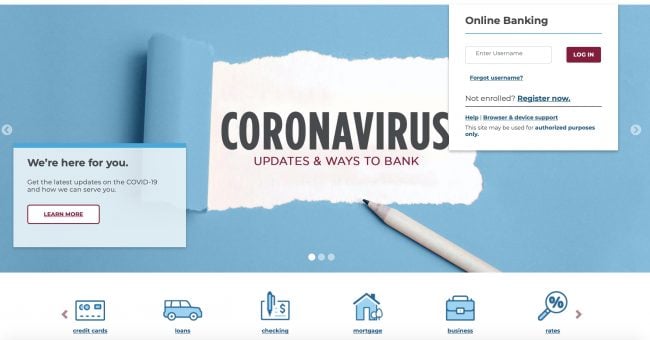 Achieva CU's marketing team meets remotely via Zoom.
Achieva CU's marketing team meets remotely via Zoom.
As we all continue to cope with the fallout from the COVID-19 crisis, this is certainly a challenging time for credit unions. We are inundated with information and charged with making decisions that can have long-term impacts on health, safety and the bottom line.
In this environment of constant change, consistent communication with members, employees and business partners is critical. And it's important to give out the information in a clear, calm style that's easy to understand.
Recommended For You
In late March, as the coronavirus began to spread in Florida, Achieva Credit Union proactively started focusing on drive-thru service at our branches, which marked a major change for members who were used to coming into our lobbies for their banking needs.
Periods of major change definitely test the quality of your communications systems. In our case, we pride ourselves on using a wide range of channels to reach our members, using everything from e-blasts and website Q&As to social media and video. Earlier this year, this approach proved to be extremely valuable as we successfully went through a core conversion, during which our systems were down for a planned timeframe that included a Monday.
As the COVID-19 crisis started to unfold, we cranked up our communications platforms again, quickly developing a special website page to house an array of coronavirus-related information and starting a regular schedule of e-blasts and social media posts. Also, understanding that members who regularly visit our branch lobbies often aren't tech-savvy, we started a series of ongoing communications to offer online banking tips and how-tos, while assuring members that using our systems is safe.
All the while, we've consistently encouraged our members to call us, knowing that some members miss their personal connections with our team.
Certainly, in every challenge lies opportunity. And as you evaluate how you can improve your communications efforts, consider these six guidelines:
1. Think about each of your key audiences. One message used in a communication does not necessarily fit all. Different audiences have different concerns, and our communications need to focus on their needs.
Employees need to hear how the credit union is making the workplace safe, how it will be handling sick leave, and if they're expected to be in the office. Members, meanwhile, want to hear about how they can do business with you with branch lobbies closed, and whether their deposits are safe.
Sometimes, in times of crisis, companies tend to focus so much on their external audiences that they neglect to consistently communicate with their own team. This internal communication is more important than ever, though, not just for proper coordination and information sharing, but for morale.
 Screenshot of Achieva CU's coronavirus web page.
Screenshot of Achieva CU's coronavirus web page. 2. Be clear and concise. Attention spans are short, especially when people are confronted with rapidly changing information. Be clear, concise and complete in your communications.
Concise writing helps the reader understand the information you're conveying, and should end with a concrete call to action if that's appropriate. And if a communication is getting long, consider breaking it up into two, or using headlines within the copy to break up the verbiage.
When possible, we use bullet points when describing steps or processes, and we take the time to self-edit, knowing that if we can say something more smoothly and clearly, readers will appreciate it.
3. Describe your safety processes. Certainly, it's important to tell your employees and members that the credit union is following CDC guidelines for cleanliness and social distancing. But telling your audiences how you are taking concrete steps to make – or keep – the facilities safe will be more reassuring.
To help reassure our audiences that we're doing everything we can, we've been offering some details about steps we're taking, whether it's posting signs and making hand sanitizer readily available, or creating guidelines for keeping personal interactions to a minimum.
4. Be clear on what working from home should look like. Most of our headquarters employees have been working remotely, and in this situation, it's important to provide clear expectations on what that should entail.
Employees who have never worked from home need to know the basics. Are my hours the same as they were before? How should I keep my fellow team members apprised of my progress on tasks? And what are the best ways for me to interact with other team members when I have a question or want to brainstorm about an issue or challenge?
Technology can be a huge help: We've found that using Zoom for internal video conferences has helped build camaraderie while providing a bit of levity as we see each other in our homes. And for our marketing department, using the web-based Asana workflow system has been more useful than ever in tracking the status of tasks.
5. Use a wide variety of communications channels. In this era of short attention spans and information overload, it's important to try to reach members in a number of ways. As an example, consider producing short, simple videos to offer tips for using the drive-thru or to talk about how the credit union is rock-solid financially.
If you are writing a blog post, create a video with someone providing several highlights of the information. You'll find that people will watch the video who wouldn't have read the post.
In addition to video, we are using e-blasts and social media, while doing news releases on significant developments. We know that the news media won't necessarily produce stories on a change in our branch operations, but posting a release on news websites helps our news gain visibility in internet searches.
And of course, there's often no substitute for a phone call, as our external-facing team members reach out to members they have relationships with, seeing how we can be of help in this challenging time.
6. Don't worry that you might be overcommunicating. There will be times when you worry that you're talking about the situation too much. But consider that worried employees and members may have missed your last communication and are eager for any news you can provide.
This is a situation that is evolving quickly, so we believe in communicating frequently, especially if there are changes in the situation or in our policies. And if some of the information is a bit repetitive, that's OK.
 David Oak
David Oak David Oak is Chief Marketing Officer for Achieva Credit Union in Dunedin, Fla.
© Touchpoint Markets, All Rights Reserved. Request academic re-use from www.copyright.com. All other uses, submit a request to [email protected]. For more inforrmation visit Asset & Logo Licensing.






